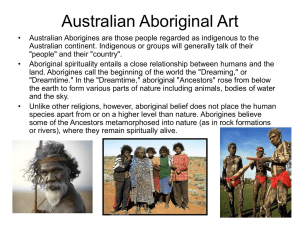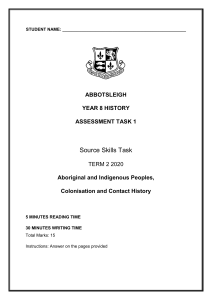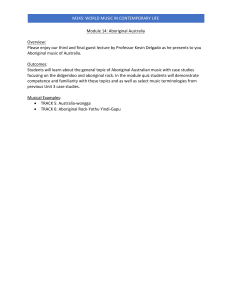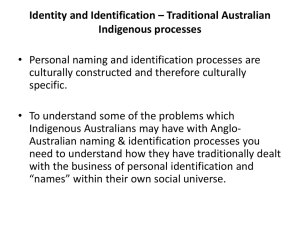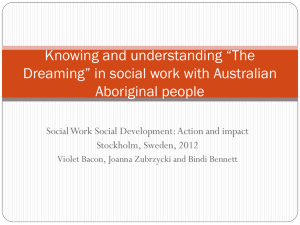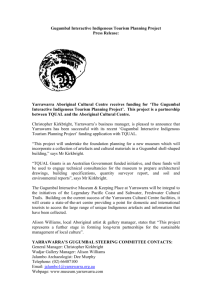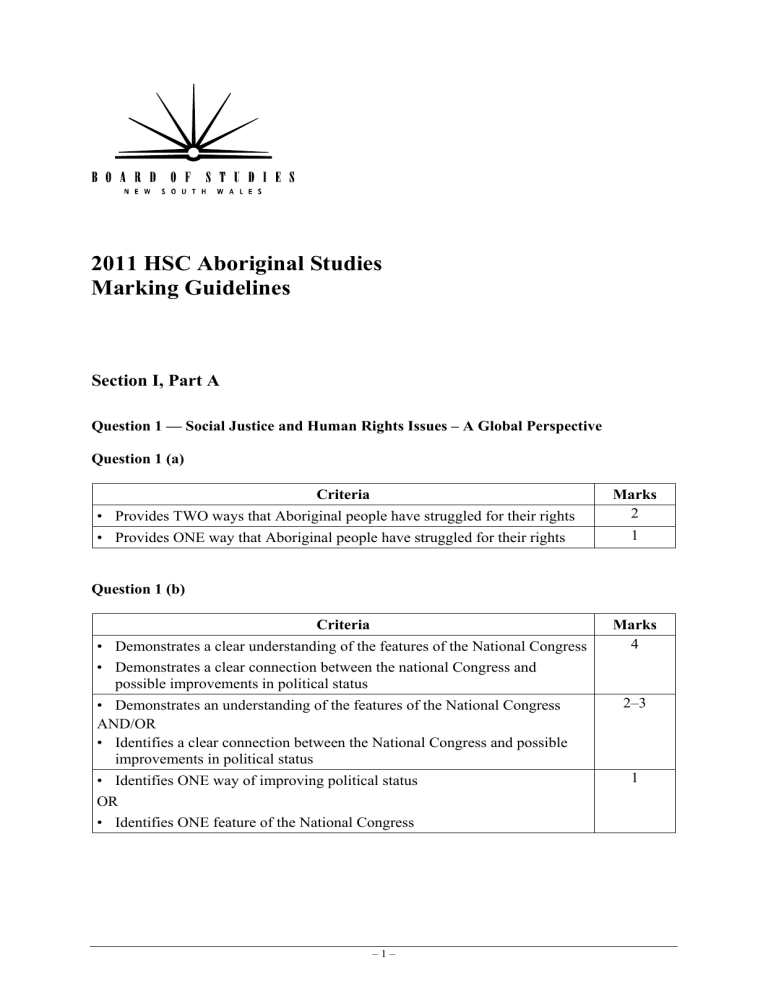
2011 HSC Aboriginal Studies Marking Guidelines Section I, Part A Question 1 — Social Justice and Human Rights Issues – A Global Perspective Question 1 (a) Criteria • Provides TWO ways that Aboriginal people have struggled for their rights • Provides ONE way that Aboriginal people have struggled for their rights Marks 2 1 Question 1 (b) Criteria • Demonstrates a clear understanding of the features of the National Congress • Demonstrates a clear connection between the national Congress and possible improvements in political status • Demonstrates an understanding of the features of the National Congress AND/OR • Identifies a clear connection between the National Congress and possible improvements in political status • Identifies ONE way of improving political status OR • Identifies ONE feature of the National Congress –1– Marks 4 2–3 1 2011 HSC Aboriginal Studies Marking Guidelines Question 1 (c) Criteria • Provides clear features of one or more methods used by governments to address Aboriginal peoples’ political status • Provides some features of one or more methods used by governments to address Aboriginal peoples’ political status Marks 4 2–3 1 • Identifies a government response Question 1 (d) Criteria • Provides a sustained, cohesive and logical response • Demonstrates comprehensive understanding of the concept of recognition in society • Makes an informed judgement about the extent to which Aboriginal people have achieved recognition, supported by relevant examples • Integrates reference to source material and their own knowledge Marks 9–10 • Provides a cohesive and logical response • Demonstrates sound understanding of the concept of recognition in society • Makes a judgment about the extent to which Aboriginal people have achieved recognition, supported by examples • Makes reference to source material and their own knowledge 7–8 • Demonstrates some understanding of the concept of recognition in society • Attempts to make a judgement about the extent to which Aboriginal people have achieved recognition, supported by examples • Makes limited reference to source material and own knowledge 5–6 • Gives an opinion and/or examples about Aboriginal people’s recognition in society • May refer to sources and/or own knowledge 3–4 • Provides some basic information AND/OR • May refer to a source or own knowledge 1–2 –2– 2011 HSC Aboriginal Studies Marking Guidelines Section I, Part B Question 2 — Health Question 2 (a) Criteria • Provides THREE indicators of health standards in Aboriginal communities Marks 3 • Provides TWO indicators of health standards in Aboriginal communities 2 • Provides ONE indicator of health standards in Aboriginal communities 1 Question 2 (b) Criteria • Demonstrates sound knowledge of Aboriginal health • Clearly explains the relationship between culture and Aboriginal health Marks 5 • Demonstrates knowledge of Aboriginal health issues • Makes a connection between culture and Aboriginal health 3–4 • Makes general statements about Aboriginal health and/or culture 1–2 –3– 2011 HSC Aboriginal Studies Marking Guidelines Question 2 (c) Criteria • Provides a sustained, logical and cohesive response • Displays extensive knowledge about community-based initiatives in Indigenous health • Clearly demonstrates the effect that community-based initiatives have on the health of Indigenous peoples • Makes detailed reference to an Australian and an international Indigenous community Marks 10–12 • Provides a logical and cohesive response • Displays sound knowledge about community-based initiatives in Indigenous health • Demonstrates the effect that community-based initiatives have on the health of Indigenous peoples • Makes references to an Australian and an international Indigenous community 7–9 • Displays some knowledge about community-based initiatives in Indigenous health • Demonstrates some knowledge of the health of Indigenous peoples • Makes references to an Australian and/or an international Indigenous community 4–6 • Displays limited knowledge about community-based initiatives on Indigenous health • May make limited references to an Australian and/or an international Indigenous community 2–3 • Recounts basic information about Indigenous health AND/OR • Makes limited reference to Indigenous communities 1 Question 3 — Education Question 3 (a) Criteria • Provides features of ONE impact of colonisation on Aboriginal education Marks 3 • Provides a feature of ONE impact of colonisation on Aboriginal education 2 • Refers to colonisation generally AND/OR • Makes general statements about Aboriginal education 1 –4– 2011 HSC Aboriginal Studies Marking Guidelines Question 3 (b) Criteria • Demonstrates sound knowledge of Aboriginal education outcomes • Clearly makes the connection between socioeconomic status and educational outcomes Marks 5 • Demonstrates knowledge of Aboriginal education outcomes • Makes the connection between socioeconomic status and education outcomes 3–4 • Makes general statements about Aboriginal education and/or socioeconomic status 1–2 Question 3 (c) Criteria • Provides a sustained, logical and cohesive response • Displays extensive knowledge about community-based initiatives in Indigenous education • Clearly demonstrates the effect of community-based initiatives on Indigenous education • Makes detailed reference to an Australian and an international Indigenous community Marks 10–12 • Provides a logical and cohesive response • Displays sound knowledge about community-based initiatives in Indigenous education • Demonstrates the effect of community-based initiatives on the education of Indigenous people • Makes references to an Australian and an international Indigenous community 7–9 • Displays some knowledge about community-based initiatives in Indigenous education • Demonstrates some knowledge of Indigenous education. • Makes references to an Australian and/or an international Indigenous community 4–6 • Displays limited knowledge about community-based initiatives in Indigenous education • May make limited references to an Australian and/or an international Indigenous community 2–3 • Recounts basic information about Indigenous education AND/OR • Makes limited reference to Indigenous communities –5– 1 2011 HSC Aboriginal Studies Marking Guidelines Question 4 — Housing Question 4 (a) Criteria • Provides features of ONE Aboriginal initiative to improve housing Marks 3 • Provides a feature of ONE Aboriginal initiative to improve housing 2 • Refers to housing or Aboriginal initiatives generally 1 Question 4 (b) Criteria • Demonstrates sound knowledge about Aboriginal housing • Clearly identifies the ongoing connection between colonisation and housing Marks 5 • Demonstrates some knowledge about Aboriginal housing • Identifies a connection between colonisation and housing 3–4 • Makes a general statement about colonisation and/or housing 1–2 –6– 2011 HSC Aboriginal Studies Marking Guidelines Question 4 (c) Criteria • Provides a sustained, logical and cohesive response • Demonstrates extensive knowledge about housing in Indigenous communities • Clearly identifies the relationship between housing, land and culture • Makes detailed reference to an Australian and an international Indigenous community Marks 9–12 Provides a logical and cohesive response Demonstrates sound knowledge about housing in Indigenous communities Identifies the relationship between housing and land and culture Makes references to an Australian and an international Indigenous community 7–9 • Demonstrates knowledge about housing in Indigenous communities • Identifies some knowledge of the relationship between housing and/or land and/or culture • Makes references to an Australian and/or an international Indigenous community 4–6 • Demonstrates limited knowledge about housing in Indigenous communities and/or land and culture • May make limited references to an Australian and/or an international Indigenous community 2–3 • • • • • Recounts basic information about Aboriginal housing and/or land and culture AND/OR • Makes limited reference to Indigenous communities 1 Question 5 — Employment Question 5 (a) Criteria • Provides features of ONE impact of colonisation on Aboriginal employment Marks 3 • Provides a feature of ONE impact of colonisation on Aboriginal employment 2 • Refers to colonisation generally and/or Aboriginal employment and/or quality of life 1 –7– 2011 HSC Aboriginal Studies Marking Guidelines Question 5 (b) Criteria • Demonstrates sound knowledge of Aboriginal employment • Clearly identifies the ways that Aboriginal initiatives impact on Aboriginal employment Marks 5 • Demonstrates some knowledge of Aboriginal employment • Identifies a connection between Aboriginal initiatives and employment 3–4 • Makes a general statement about Aboriginal initiatives and/or employment 1–2 Question 5 (c) Criteria • Provides a sustained, logical and cohesive response • Displays extensive knowledge about employment outcomes for Indigenous communities • Clearly makes the connection between socioeconomic status and employment outcomes • Makes detailed reference to an Australian and an international Indigenous community Marks 10–12 • Provides a logical and cohesive response • Displays sound knowledge about employment outcomes for Indigenous communities • Makes the connection between socioeconomic status and employment outcomes • Makes references to an Australian and an international Indigenous community 7–9 • Displays some knowledge about employment outcomes for Indigenous communities • Makes some link between socioeconomic status and employment • Makes references to an Australian and/or an international Indigenous community 4–6 • Demonstrates limited knowledge about employment outcomes for Indigenous communities • May make limited references to an Australian and/or an international Indigenous community 2–3 • Recounts basic information about employment and/or socioeconomic status AND/OR • Makes limited reference to Indigenous communities –8– 1 2011 HSC Aboriginal Studies Marking Guidelines Question 6 — Criminal Justice System Question 6 (a) Criteria • Provides THREE indicators of Aboriginal over-representation in the criminal justice system Marks 3 • Provides TWO indicators of Aboriginal over-representation in the criminal justice system 2 • Provides ONE indicator of Aboriginal over-representation in the criminal justice system 1 Question 6 (b) Criteria • Demonstrates sound knowledge about changes within law enforcement and judicial agencies that have impacted on outcomes for Aboriginal people • Makes a judgement about the extent to which changes within law enforcement and judicial agencies have impacted on outcomes for Aboriginal people Marks 5 • Demonstrates some knowledge about changes within law enforcement and judicial agencies that have impacted on outcomes for Aboriginal people • Makes a connection between changes in law enforcement and judicial agencies, and improved outcomes for Aboriginal people 3–4 • Makes general statements about criminal justice and/or types of changes that could occur 1–2 –9– 2011 HSC Aboriginal Studies Marking Guidelines Question 6 (c) Criteria • Provides a sustained, logical and cohesive response • Demonstrates extensive knowledge about the key social justice and human rights issues faced by Indigenous people in the criminal justice system • Provides points for and/or against strategies to address social justice and human rights issues • Makes detailed reference to an Australian and an international Indigenous community Marks 9–12 • Provides a logical and cohesive response • Demonstrates sound knowledge about the key social justice and human rights issues faced by Indigenous people in the criminal justice system • Provides points for and/or against a strategy to address social justice and human rights issues • Makes references to an Australian and an international Indigenous community 6–8 • Demonstrates some knowledge about social justice and human rights issues faced by Indigenous people in the criminal justice system • May consider some strategies related to social justice and human rights issues • Makes references to an Australian and/or an international Indigenous community 4–5 • Demonstrates limited knowledge about issues faced by Indigenous people in the criminal justice system and/or refers to strategies • May make limited references to an Australian and/or an international Indigenous community 2–3 • Recounts basic information about Indigenous peoples' involvement in the criminal justice system and/or the related social justice and human rights issues and/or strategies AND/OR • Makes limited reference to Indigenous communities 1 Question 7 — Economic Independence Question 7 (a) Criteria • Provides THREE indicators of Aboriginal peoples’ participation in the economy Marks 3 • Provides TWO indicators of Aboriginal peoples’ participation in the economy 2 • Provides ONE indicator of Aboriginal peoples’ participation in the economy 1 – 10 – 2011 HSC Aboriginal Studies Marking Guidelines Question 7 (b) Criteria • Demonstrates sound knowledge of economic independence • Clearly identifies ways in which Aboriginal communities have attempted to assert their economic independence Marks 5 • Demonstrates some knowledge of economic independence • Identifies some ways in which Aboriginal communities have attempted to assert their economic independence 3–4 • Makes general statements about economic independence 1–2 Question 7 (c) Criteria • Provides a sustained, logical and cohesive response • Demonstrates extensive knowledge about economic independence in Indigenous communities • Clearly identifies the relationship between economic independence, and land and culture • Makes detailed reference to an Australian and an international Indigenous community Marks 10–12 • Provides a logical and cohesive response • Demonstrates sound knowledge about economic independence in Indigenous communities • Identifies the relationship between economic independence, and land and culture • Makes references to an Australian and an international Indigenous community 7–9 • Demonstrates knowledge about economic independence in Indigenous communities • Identifies some knowledge of the relationship between economic independence and/or land and/or culture • Makes references to an Australian and/or an international Indigenous community 4–6 • Demonstrates limited knowledge about economic independence in Indigenous communities • May make limited references to an Australian and/or an international Indigenous community 2–3 • Recounts basic information about Aboriginal economic independence AND/OR • Makes limited reference to Indigenous communities 1 – 11 – 2011 HSC Aboriginal Studies Marking Guidelines Section II Question 8 — Aboriginality and the Land Question 8 (a) Criteria • Provides a sustained, logical and cohesive response • Demonstrates comprehensive knowledge of the responses to government decisions about land and water rights • Clearly identifies government decisions about land and water rights • Integrates reference to the source material and own knowledge Marks 9–10 • Provides a logical and cohesive response • Demonstrates detailed knowledge of the responses to government decisions about land and water rights • Identifies government decisions about land and water rights • Makes reference to the source material and own knowledge 7–8 • Demonstrates some knowledge of the responses to government decisions about land and/or water rights • Refers to government decisions about land and water rights (may be implied) • Makes limited reference to source material and/or own knowledge 5–6 • Provides limited detail regarding government decisions and/or responses • Makes limited reference to source material and/or own knowledge 3–4 • Provides basic information regarding government decisions and/or responses AND/OR • May refer to source material and/or own knowledge 1–2 – 12 – 2011 HSC Aboriginal Studies Marking Guidelines Question 8 (b) Criteria • Provides a sustained, logical and cohesive response • Demonstrates extensive knowledge of responses to land and water rights • Makes clear connection between these responses and the social, political and cultural lives of Aboriginal peoples • Makes specific and detailed references to Local Aboriginal Case Study Marks 17–20 • Provides a logical and cohesive response • Demonstrates detailed knowledge of responses to land and water rights • Makes connections between responses and the social, political or cultural lives of Aboriginal peoples • Makes specific reference to Local Aboriginal Case Study 13–16 • Demonstrates sound knowledge of responses to land and water rights • Attempts to link responses to land and water rights to the social, political or cultural lives of Aboriginal peoples • Makes references to Local Aboriginal Case Study 9–12 • Demonstrates limited knowledge of responses to land and water rights • Makes some reference to responses to land and water rights with the social, political or cultural lives of Aboriginal people • May make limited references to Local Aboriginal Case Study 5–8 • Provides basic information on land and water rights and/or responses to land and water rights and/or the social, political or cultural lives of Aboriginal people AND/OR • May make limited reference to the Local Aboriginal Case Study 1–4 – 13 – 2011 HSC Aboriginal Studies Marking Guidelines Question 9 — Heritage and Identity Question 9 (a) Criteria • Provides a sustained, logical and cohesive response • Demonstrates extensive knowledge regarding stereotypes about Aboriginality • Clearly identifies ways in which stereotypes contribute to discrimination • Integrates reference to the source material and own knowledge • • • • Provides a logical and cohesive response Demonstrates detailed knowledge regarding stereotypes about Aboriginality Identifies the ways in which stereotypes contribute to discrimination Makes reference to the source material and own knowledge Marks 9–10 7–8 • Demonstrates some knowledge regarding stereotypes and/or Aboriginality • Identifies the ways in which stereotypes contribute to discrimination • Makes limited reference to source material and/or own knowledge 5–6 • Provides limited detail regarding stereotypes and/or discrimination • Makes limited reference to source material and/or own knowledge 3–4 • Provides limited detail regarding stereotypes and/or discrimination AND/OR • May refer to source material and/or own knowledge 1–2 – 14 – 2011 HSC Aboriginal Studies Marking Guidelines Question 9 (b) Criteria • Provides a sustained, logical and cohesive response • Displays extensive knowledge of non-Aboriginal responses to Aboriginality • Clearly identifies the relationship between expressions of Aboriginality and non-Aboriginal responses • Makes specific references to Local Aboriginal Case Study Marks 17–20 • Provides a logical and cohesive response • Displays detailed knowledge of non-Aboriginal responses to Aboriginality • Identifies the relationship between expressions of Aboriginality and nonAboriginal responses • Makes specific references to Local Aboriginal Case Study 13–16 • Displays sound knowledge of non-Aboriginal responses to Aboriginality • Comments on these responses and expressions of Aboriginality • Makes references to Local Aboriginal Case Study 9–12 • Demonstrates limited knowledge of expressions of Aboriginality and nonAboriginal responses • May make limited reference to Local Aboriginal Case Study 5–8 • Provides basic information about Aboriginality and/or responses to Aboriginality AND/OR • May make limited reference to the Local Aboriginal Case Study 1–4 – 15 – 2011 HSC Aboriginal Studies Marking Guidelines Section III Question 10 — Research and Inquiry Methods – Major Project Question 10 (a) Criteria • Clearly describes the ways taken to make the project accurate Marks 4 • Describes a way taken to make the project accurate 2–3 • Makes a general statement about the Major Project 1 Question 10 (b) Criteria • Clearly describes the sources used in the Major Project • Clearly identifies how the chosen sources reflect a variety of perspectives Marks 5–6 • Describes sources used in the Major Project • Identifies how some sources reflect some different perspectives 3–4 • Gives some information about sources AND/OR • Gives some information about perspectives 1–2 – 16 – Aboriginal Studies 2011 HSC Examination Mapping Grid Section I Part A Question Marks Content Syllabus outcomes 1 (a) 2 Social Justice and Human Rights H2.3 1 (b) 4 Social Justice and Human Rights H2.3, H3.3 1 (c) 4 Social Justice and Human Rights H3.2 1 (d) 10 Social Justice and Human Rights H3.3, H4.5 Section I Part B Question Marks Content Syllabus outcomes 2 (a) 3 Health H2.3 2 (b) 5 Health H2.1 2 (c) 12 Health H3.3, H4.5 3 (a) 3 Education H1.2 3 (b) 5 Education H3.2 3 (c) 12 Education H3.3, H4.5 4 (a) 3 Housing H3.3 4 (b) 5 Housing H1.1 4 (c) 12 Housing H3.2, H3.3, H4.5 5 (a) 3 Employment H1.2 5 (b) 5 Employment H3.3 5 (c) 12 Employment H2.3, H4.5 6 (a) 3 Criminal Justice H2.3 6 (b) 5 Criminal Justice H1.2 6 (c) 12 Criminal Justice H3.1, H4.5 7 (a) 3 Economic Independence H2.3 7 (b) 5 Economic Independence H3.3 7 (c) 12 Economic Independence H2.1, H4.5 Section II Question Marks Content Syllabus outcomes 8 (a) 10 Aboriginality and The Land H2.1, H3.1, H4.1 8 (b) 20 Aboriginality and The Land H2.1, H2.3, H3.2 9 (a) 10 Heritage and Identity H1.3, H2.2 9 (b) 20 Heritage and Identity H1.3, H2.2, H4.1 Section III Question Marks Content Syllabus outcomes 10 (a) 4 Research and Inquiry Methods H4.1, H4.4 10 (b) 6 Research and Inquiry Methods H4.3, H4.4 –1–
